
|
|
 |

|


|
VIZIO XVT3D650SV Review
65" Edge-lit LED 3D HDTV, $3699
Out of the Box
Even with its skinny profile, this 65" TV is not light and extricating the XVT3D650SV is not a casual endeavor. To their credit, VIZIO makes the task a bit easier by packaging the TV with its stand attached. 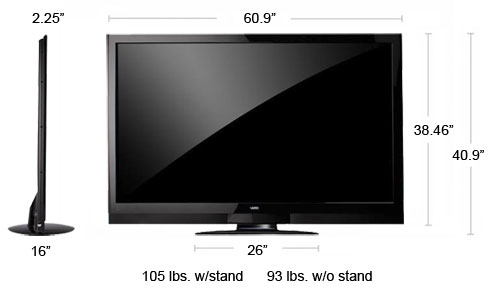 Of course, if you want to wall mount this beast, that's another undertaking that luckily I did not have to solve. The TV does not swivel on its stand, but this large screen offers a good viewing angle for a whole passel of people. Though for the best viewing of 3D content, VIZIO suggests that you place the TV so that the midpoint of the screen's height is at your eye line. 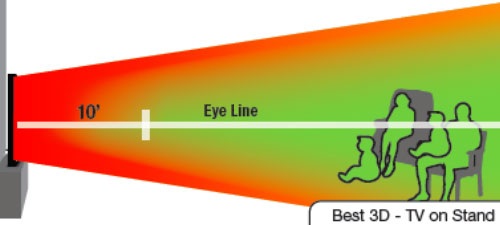 If you are locating the TV above your head, then tilt the mount so that the screen is perpendicular to your eye line. 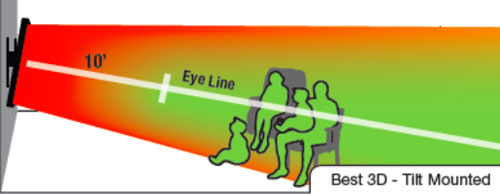 VIZIO also recommends sitting at least 10 feet away for best 3D viewing. I find that I can sit closer than ten feet and still see good quality 3D. Anything nearer than five feet is pushing it. Remember that this is a 65" TV. With that huge screen you don't need to nestle up to it to achieve an eye filling experience. Since the front of the screen is more reflective than many TVs I have seen, I recommend that you place the TV in a room where you can control the light that may reflect on the screen. Ideally, you have a home theater environment where you can extinguish any and all annoying lights. I don't want to overstate this situation because for many of you, when the TV is turned on, you won't be bothered with an occasional offending glare. But if you are one of those types that doesn't want anything to detract from your viewing enjoyment, then plan to darken the room. 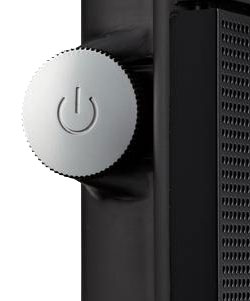
With that settled, let's examine the TV itself. With the XVT3D650SV, the VIZIO designers have employed many of the same elements that I have discussed in my reviews of some of their recent models. For example, all of the usual operational buttons (Power, Channels, Input Source, Volume) are combined into one silver Jag wheel located along the back of left edge of the TV. By pressing or turning the wheel, you can handle all the basic functions. To navigate deeper into the menus, you still need the remote control, which I will discuss later. 
Above the Jag wheel on the left side running vertically is a long connection panel containing five HDMI inputs, one optical audio out, one stereo analog audio out and three USB ports. The manual simply describes these three inputs "For service technician use only." The major omission is that, at this time, the ports will not accept a USB flash drive containing music, photos or videos. Many of the VIZIO TVs that I have reviewed lately have included this capability. Why this top of the line series does not is puzzling. The Tech Specs on the VIZIO website entices with "multimedia support via future firmware update." Below this panel, running horizontally, with the connections facing down, the second panel supplies one set of Component video (YPbPr) Ins (with one matching stereo Audio In) and one RGB PC In (with a matching stereo minijack Audio out). VIZIO includes a LAN port for connecting to the Internet with an Ethernet cable. The XVT3D650SV also has an integrated WiFi 802.11n dual-band wireless connection, which matches well with their XWR100 dual-band router (which I reviewed here). The one RF antenna connector links to integrated ATSC/QAM tuners. Since the tuner system is Clear QAM compatible, you can attach your cable TV signal directly into the RF connector and tune in unscrambled cable stations.  With the ATSC tuner and the proper antenna, you also will be able to tune in digital signals broadcast over-the-air. 
For those of you who are eyeballing your TV as a big screen for watching Internet content, a simple press of the VIA (VIZIO Internet Apps) button on the remote opens up a whole world of programming including popular providers like Netflix, Vudu, Hulu Plus and Amazon Video on Demand. Beyond the streaming movie widgets, VIZIO provides other video streaming apps. For a wider range of programs, I particularly like the 60 channels that are aggregated under the Web Videos widget. Major outlets like CBS, Fox, WB and PBS usually offer only clips from their programs. But if you dig deeper into the list of choices, you can find all sorts categories like the eponymous music video channels, Justin Bieber, Rihanna, Kanye West, Mariah Carey and Bon Jovi. 
To widen your musical reach, VIA includes Rhapsody and Pandora. Photo freaks can feast on Flickr. Social butterflies can flit on Facebook and Twitter. Shoppers can spend on eBay and QVC. And the list goes on and on with the only major omission being YouTube. If you really can't live without YouTube, or for that matter, the capability to playback photos, music and video from USB media then you can find any number of Blu-ray players or standalone media servers that supply these features. I was planning to leave out this next piece of advice that I constantly repeat, but as I was swooning to one of the Justin Bieber's music videos, the stream stuttered and halted more than once. A lot of elements are involved in delivering a constant high quality stream to your TV, many of them you have very little control over. But if you are serious about streaming, what you can do is obtain the highest bandwidth from your Internet provider that you can afford, ideally over 10Mbps. Even fast bandwidth is not a guarantee of a smooth stream. My PC is clocking over 15Mbps. (The TV is testing the connection at over 7Mbps.) And still Justin jittered. 
Also, I find running an Ethernet cable faster and more reliable than a wireless solution. If you do decide on wireless with the XVT3D650SV, consider matching it with the XWR100, VIZIO's wireless dual-band router. One last note about streaming video, the native picture quality of a lot of video available (especially on sites like YouTube) is low resolution and not pretty. Now imagine blowing it up on to a five foot wide screen. It's like looking at teenage acne with a magnifying mirror. Some content is better experienced on a smart phone. On the flip side, a 65" screen is made for PIP (Picture-in-Picture) and POP (Picture-outside-picture), and VIZIO provides both modes. The two side by side POP images are about the same size as you would see on 35" TV - perfect for watching two basketball games simultaneously. But as with most TVs, the combination of sources is limited. For example, you cannot mix two HDMI sources at once. The non-backlit remote control is stubbier than usual, but the buttons are well laid out and the labels are easy to read. The real surprise is when you slide the bottom of the remote out to reveal a QWERTY keyboard, which makes tweeting so much easier. 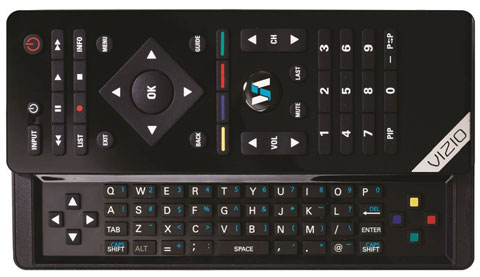 This remote can be operated in either IR or Bluetooth mode. IR (infrared) is the traditional method, but it requires you to point the remote at the TV. Bluetooth has a similar range of around 30 feet, but you do not have to aim the remote at the TV for it to work. If you want the convenience of the Bluetooth mode, you will need to pair it with the television. During the initial power-up of the XVT3D650SV, the Setup App will lead you through the simple procedure. If you want to activate Bluetooth later, the manual is well written with photos and screen shots that guide you through setting up and using all aspects of the TV. To its credit, the manual does a better than average job of explaining items like the Advanced Picture options. Power Consumption
On May 1, 2010, the EPA implemented Version 4.1 of the ENERGY STAR Program Requirements for TVs. They are now publishing a list of TVs that that meet this stricter standard. (You can find it here.) The VIZIO XVT3D650SV is on the list, all 1776 square inches of screen area. 
To put that in context, a 55" TV is about 1276 sq. inches, making the 65" almost 40% larger. Of course that extra real estate requires more power. The EPA states that this VIZIO's On Mode Power is 185W and Standby Power Consumption is .7W. Based on the formula that the TV is on five hours a day and in Standby for the other 19, the Estimated Annual Energy Use is 342.48 kWh/year. You need to check your electric bill to see how much you are paying for a kWh. The rate that I have been using in previous reviews is 10.4 cents. Doing the multiplication, at that rate, the yearly energy cost is $35.62. Later this year, we will begin to see manufacturers attaching those yellow ENERGY STAR tags that you find on air conditioners and refrigerators. Until then you will have to study the ENERGY STAR list to see how the XVT3D650SV compares to other 65" TVs. From my quick survey, you won't find a lot of models that large on the list and of those, this VIZIO is in the middle of the pack. (The Maximum On Mode Power for Energy Star Qualification is 238W for 65" screens.) Setup
The first time that you ever turn on this TV, the Setup App does a very good job of guiding you through procedures like turning on the Bluetooth feature on your remote and more importantly, on connecting your TV to the Internet. 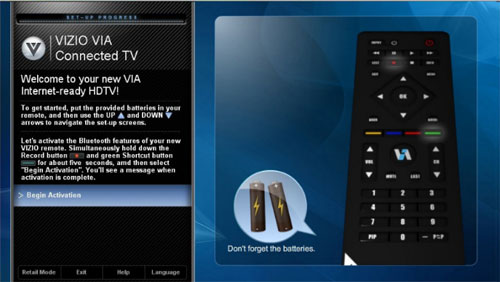 To calibrate the TV, we have added a third disc, WOW (World of Wonder) from Disney, to our usual two, the Blu-ray version of the Digital Video Essentials DVD called HD Basics and the Spears & Munsil High Definition Benchmark Blu-ray DVD. We are playing the DVDs on the Samsung BD-C7900 3D Blu-ray player connected to the HDTV with an HDMI cable. We use the test patterns to adjust black level, white level, and color bias. The player is set to output a 1080p signal, which is the native resolution of the XVT3D650SV. I always suggest that you test drive the Picture modes provided by the TV. If you find one that you like, then you can either pick it and quit or use it as a reference to guide your own setup. 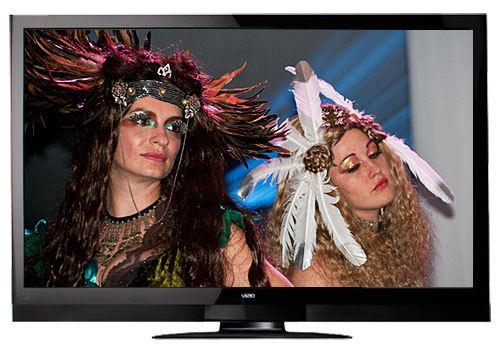 VIZIO offers a long list of Picture modes: Standard, Movie, Game, Vivid, Football, Golf, Basketball, Baseball, and Custom. Cruising through them can be educational by examining what adjustments were made to achieve the look. Take a long, hard look at the Movie default, which is closest to a "proper" calibration setting. Though I realize that Movie may be too muted for some of you, especially if you are watching sports. Be that as it may, for my setup, I picked Movie. Before I give you my final settings, let me say that everybody's combination of equipment is different. Use these numbers as guidelines and starting points. Then adjust according to your environment, aesthetics and content. 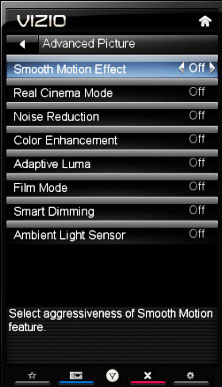
To begin, I went into the Advanced Picture Settings and turned Off everything like Color Enhancement, Adaptive Luma, and Ambient Light Sensor. I like to adjust initial settings without the interference of these options. For example, if Ambient Light Sensor is On, then you have no control over the Backlight setting. There is one exception with the XVT3D650SV, I left Smart Dimming turned On. I really like this feature and therefore I figured that I should have it engaged when I am setting up the display. Then, I proceeded to Color Temperature. The choices are Cool, Computer, Normal and Custom. Notice that Warm isn't an option. I picked Normal, which tends to be a little Warm. (For the geeks, Normal sets the White Point to 6500K.) If you really want to tweak, you can individually adjust the Gain and Offset for Red, Green and Blue. Next I worked my way down the Picture Settings menu. I moved Backlight to 37. Your number may vary depending on the lighting conditions in your room. Of course, if the light really varies, then you might consider turning on the Ambient Light Sensor and letting it adjust the Backlight according to the light in the room. Moving on, according to the test patterns, Brightness was 51, Contrast dropped to 49, Tint was left at 0, and Color was lowered to 47. (For my tastes, even then Color was too high and I dropped it to 43.) Any setting over 3 for Sharpness started to create fringing on the edges of lines. I left it at 3. 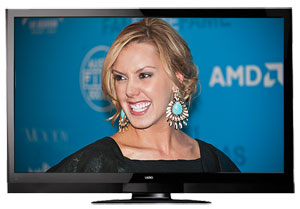
This initial process was quick and easy. Better yet, the results were quite satisfactory and consistent over a range of content. If you must tweak, then proceed back to the Advanced Picture menu and experiment with Adaptive Luma and Color Enhancement. Before we leave this menu, we should cover the Smooth Motion Effect and Real Cinema mode features. This VIZIO LCD is a 120Hz display. I have often discussed the MEMC (motion estimation, motion compensation) technology that interpolates 60 frame per second content (60Hz) and creates 120 frames per second (120Hz). You can read more about how it works here. Let me cut to the chase. I turned off Real Cinema and Smooth Motion because I find that MEMC makes the image appear too sharp and video-like, which can be discomforting when watching movies. Of course, if you yearn for that tack sharp image, then you should be fine with Smooth Motion at Medium and Real Cinema at Smooth. As for Picture settings in 3D mode, I found that when I activated 3D, the TV took over the Picture controls and most notably raised Sharpness to 8 and pushed the Backlight to the maximum, which is understandable since the passive polarizing glasses do cut down on the brightness of the image. Finally, before you can enjoy many of the Internet apps, you must initialize them. Some, like Netflix, require a subscription and then you activate your TV on the Netflix site. Others, like Facebook or Pandora, simply require you to enter your ID and password. |
Bookmark:
![]() del.icio.us
del.icio.us
![]() Reddit
Reddit
![]() Google
Google
| Send this Page | Print this Page | Report Errors |

